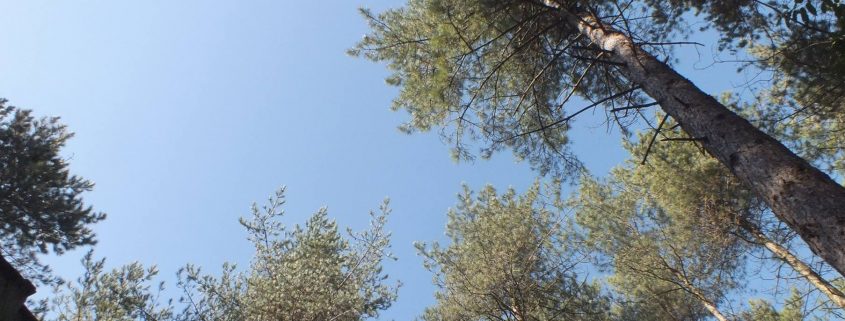
Parkhurst Forest – Red Squirrel Hide
The Island is famous for its red squirrels and has one of the best and the last English populations of this shy woodland animal. Parkhurst Forest near Newport is one of the best places to search for them and you might be lucky enough to see some from the magnificent log cabin hide which we built with the help of the Forestry Commission. The hide is specially designed with a high roof to allow you to look up into the treetops to watch for a display of nimble squirrels.
The red squirrel is Britain’s only native squirrel. The Island’s population has been able to thrive due to the absence of grey squirrels. Grey squirrels were introduced to Britain around the end of the eighteenth century. It is uncertain why this was done but likely that the Victorians had little understanding of the damage this would cause. Red squirrels have also suffered due to the loss of their habitats; they are able to live in a wide range of forest types, but they prefer conifer because they can forage more efficiently. Red squirrels are 35 to 40cm from nose to tail, weighing only 350g. Their colouring is hugely variable, ranging from bright ginger, red through to dark brown and they can even be tinged with grey. In the winter they are particularly noticeable with their big ear tufts. Squirrel nests, called dreys, can be spotted in tree forks or hollows and are constructed from twigs and lined with moss and hair.
What to look and listen for …
Squirrels will be most likely high up in the trees. Sit still and if possible, visit early morning or late afternoon. You are actually most likely to find your squirrel through listening for it. They can be heard rustling in the tree-tops and if you hear a pitter-patter and it’s not raining, it may be a squirrel munching pine-cones – this is the noise the leftovers make as they hit the tree leaves around the hide.
There are usually robins around. They sometimes will bathe in water collected in the nutshell seats. Look for our carved squirrel at the site entrance and other carved sculptures further along the main forest path from which to access the hide.
If you walk further along woodland paths, look out for wood ant nests – these are large, and the ants do get angry if disturbed. There are some wonderful fungi along the woodland paths, and these are particularly good in Autumn. However, many are toxic so do not touch, and certainly do not ingest.
At Parkhurst you can see pearl-bordered fritillary butterflies which are regarded as nationally important. This butterfly is scarce locally, and its population is declining. The caterpillar and butterfly feeds on violets, which are also in decline. Your best chance to see this pretty butterfly is between late April and July in forest clearings. White admiral butterflies can be found in Parkhurst. They are a striking butterfly with a white band on black. They eat honeysuckle and are best seen near brambles in sunny glades or the cleared paths (forest rides).
These rides and clear fell areas in Parkhurst are important because the long grass habitats are great for small mammals and their predators such as the long-eared owl. You can also see sparrow hawks and buzzards. The ponds in the centre of the forest are home to great crested newts, Britain’s largest newt which can live up to 27 years. Great crested newts are dark in colour and eat insects, both in the water and on land.
… and smell and touch
Nose out the Stinking Iris – also known as roast beef plant.
Feel the different textures of the trees and their leaves. This is a mixed forest – hug a tree trunk and see if you can guess what it is, some of the trees and shrubs are sharp – Holly and Butchers Broom can be found close to our hide. here are a lot of ferns adjacent to the hide, these are so different. The fluffiness of Maidenhair Fern and the cool Hart’s Tongue. Have a hunt for pines cones – particularly those that have been eaten by squirrels.
Nature at home and activities on site
We have produced a super Colouring Sheet for you to download and complete at home. We have also produced an I Spy Sheet and Map for you to print at home, or download to your phone and take to the site. And become a Bug Bunch Ranger. All these activities and resources can be found here.
Managing the site
The Red Squirrel Viewing Hide was built in 2001 by Gift to Nature and opened by David Bellamy, it resembles a log cabin and is built mostly from oak and Douglas fir harvested from the forest. You will also see various sculptures around the hide created by local artists. In 2015 we refurbished the hide, installing new interpretation materials, magnifying posts to inspect your forest-finds and some huge leaf seats which you can relax in and gaze up into the forest canopy. We only look after the Hide. Everything else is looked after by the Forestry Commission.
How to get there
On foot/By bike – Cycling is permitted on the gravel tracks throughout the forest, so you can cycle right to the entrance to the hide area. There is a suggested route from The Red Squirrel Trail (NCN 23) via Stag Lane, and a free map available to download here. On foot you can access the hide via the forest tracks from any entrance to the forest.
By bus – Forest Corner Stop (Route 7) + 15 min walk through the forest. (Bus Timetables)
By Car – There is a large gravel car park accessed from Forest Road. Parking is currently free. The hide is a 15 minute walk away. Postcode for the car park entrance for satnav PO30 5LZ
Access
From the car park there is a path leading towards the hide which is uneven in places and can get muddy after rain. There is an alternative route via the tarmac drive to Signal House and a short section of gravel track from there to the hide.
There is a Information Pillar at the start of the path to the hide. The site information pillar has a QR code that links to an audible description creating a mind’s eye view of the area to allow a visually impaired person to enter with confidence. The information pillar also has a QR code that links to a map and activities. There is also a site map on the Information Pillar.
There are no toilets anywhere near this site. The nearest toilets are in the town of Newport.
We have written an Access Statement for this site. This includes mobility and sensory issues and opportunities. We welcome feedback from users.

We have produced an audible description creating a mind’s eye view of the area to allow a visually impaired person to enter with confidence. It will describe the entrance, the size of the area, where to find further information or help and any major obstacles or features. Information has been produced by visually impaired people ensuring it is useful and accurate. Access the description by scanning the QR code to the left of this text on your phone or tablet, or by clicking here.
Get Involved
There are various ways you can help improve and maintain our sites. We rely on volunteers to help with many tasks on our sites and also need people who are happy to regular visit the site be our “eyes and ears”, this means we can respond much quicker to issues. Our shop raises money to support our work and needs a team of volunteers. Or maybe you would like to help us with events. Find out more here.
You can also help by becoming one of our regular supporters. Even giving a few pounds each month can make a real difference, with your donation being invested into site management and improvement work to benefit site visitors and look after our precious wildlife. Sign up here.
